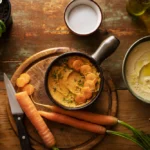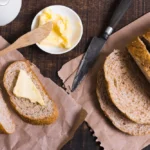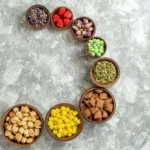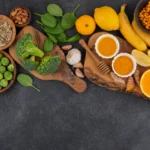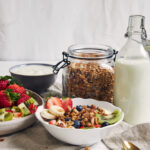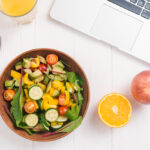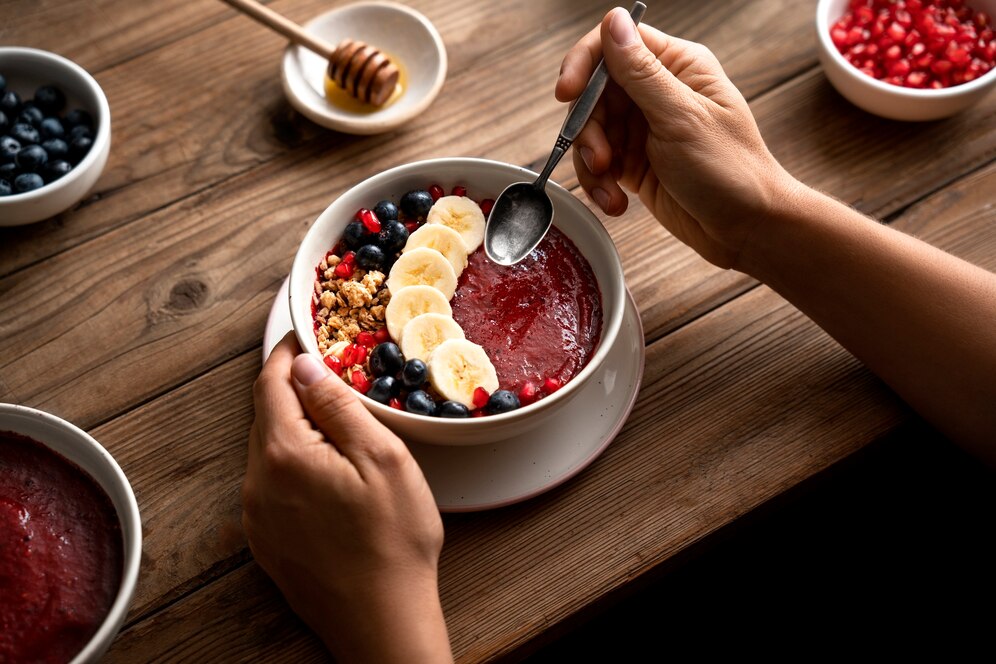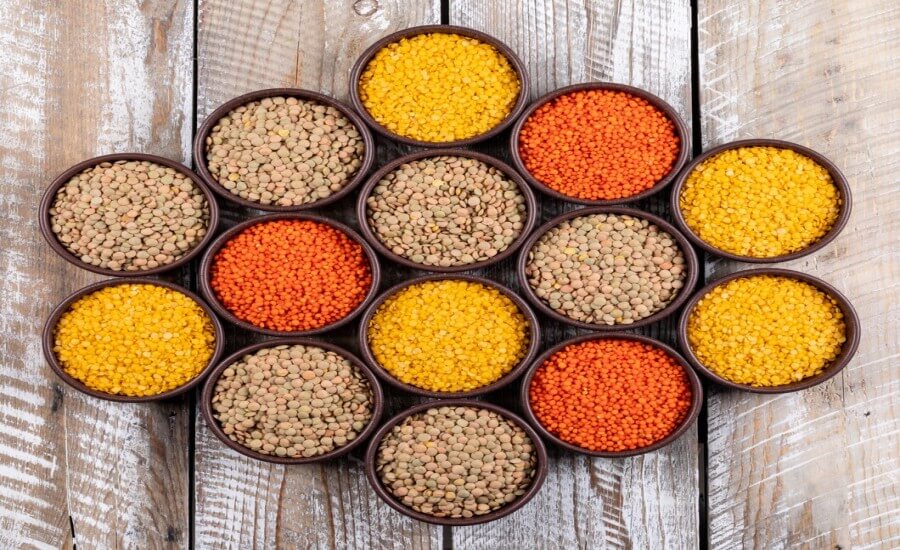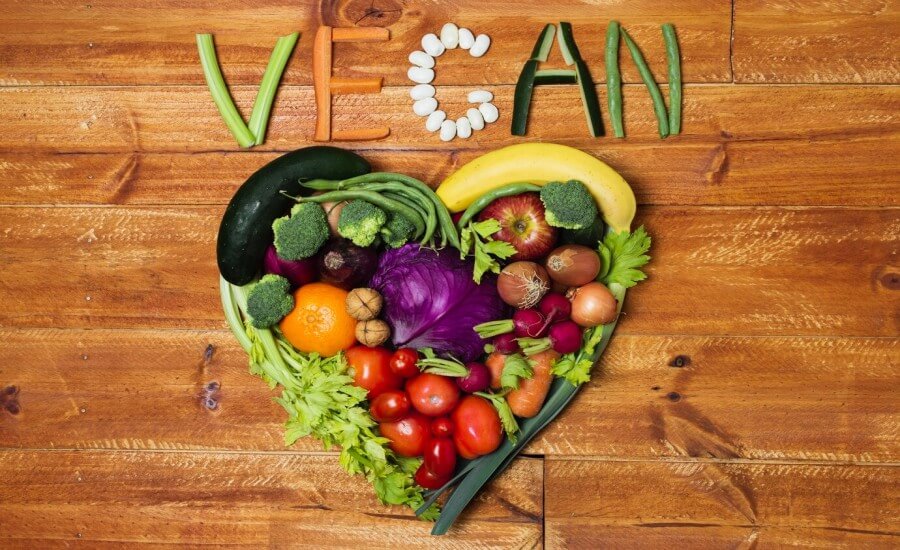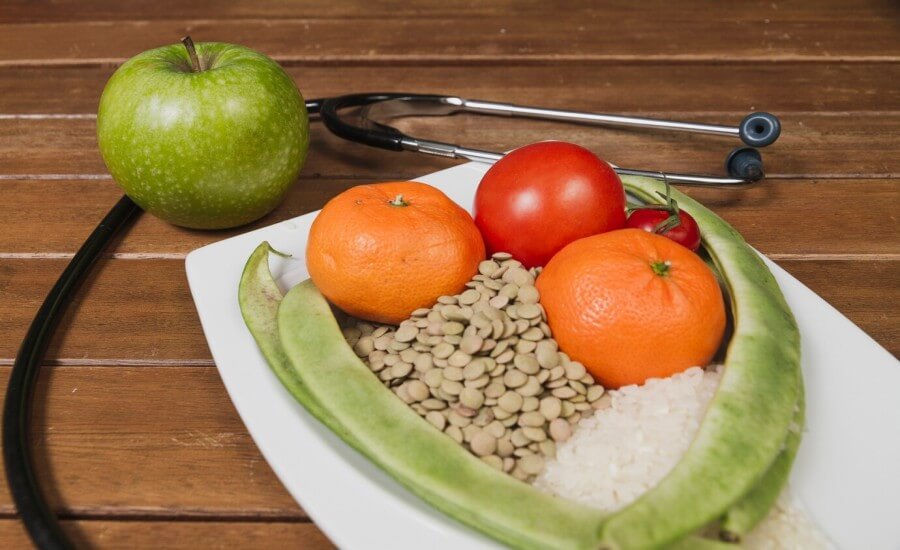Vegan Smoothie Bowls have taken the health food world by storm, captivating us with their vibrant colours, artistic toppings, and promise of a nutritious meal in a bowl. But are they just a pretty trend, or a genuinely beneficial addition to a plant-based lifestyle? This 360° analysis explores the phenomenon through multiple lenses: the practicalities for the Health-Conscious Eater, the artistry appreciated by the Food Stylist, the nutritional breakdown from the Nutritionist, the science behind the texture explained by the Food Scientist, and the cultural context viewed by the Trend Analyst. Whether enjoyed as a breakfast boost or, perhaps, a refreshing and nourishing meal on a warm Vadodara afternoon like today, this guide helps you master the art and science of the perfect vegan smoothie bowl.
Blended Beginnings: More Than Just a Smoothie
At its core, a smoothie bowl is simply a very thick smoothie, designed to be eaten with a spoon and adorned with toppings. But it represents much more: a canvas for creativity, a vehicle for nutrient density, and a delicious way to start the day or refuel anytime. Unlike its drinkable cousin, the smoothie bowl encourages slower, more mindful eating and offers greater potential for textural variety and balanced macronutrients through carefully chosen toppings. It’s a delightful fusion of health, taste, and aesthetics.
How to Make Vegan Smoothie Bowls?
LENS 1: The Practitioner’s Blend – Crafting Your Daily Bowl

From the practitioner’s viewpoint, making Vegan Smoothie Bowls is about ease, customizability, and achieving that perfect, spoonable consistency for a satisfying meal or snack.
- The Basic Formula:
- Frozen Base: Frozen fruit is key for thickness (e.g., bananas, mangoes, berries). Use at least 1-1.5 cups.
- Liquid: Start with minimal liquid (1/4 to 1/2 cup) – unsweetened plant milk, coconut water, or even plain water. Add more only if needed to blend.
- Optional Boosters: A scoop of vegan protein powder, a tablespoon of nut butter, chia seeds, flax seeds, or oats can add nutrients and thickness.
- Optional Greens: A handful of spinach or kale blends in easily without dominating the flavour (usually).
- Achieving Thickness:
- Use primarily frozen fruit. Frozen bananas and mangoes create exceptional creaminess.
- Start with very little liquid; add more tablespoon by tablespoon only if the blender struggles.
- Use a high-speed blender if possible, utilizing the tamper tool to push ingredients down.
- Add natural thickeners like chia seeds, flax seeds, or a small amount of rolled oats.
- Flavour Combinations:
- Tropical: Mango, pineapple, banana, coconut milk.
- Berry Blast: Mixed berries, banana, almond milk.
- Green Goodness: Spinach/kale, mango/pineapple, banana, plant milk.
- Chocolate Lover: Banana, cocoa/cacao powder, peanut/almond butter, plant milk.
- Local Vadodara Twist: Use seasonal mangoes, bananas, chikoo (sapota), or papaya as a base.
- Prep Hacks: Pre-portion frozen fruit, greens, and boosters into freezer bags for grab-and-blend convenience.
- Daily Impact: Starting the day with a nutrient-packed smoothie bowl can boost energy levels and provide sustained fuel. It’s a quick way to consume multiple servings of fruits and potentially vegetables/seeds, contributing positively to digestive health thanks to the fiber content. It’s also incredibly refreshing in warm climates.
- Voice of Experience (Busy Professional): “My morning smoothie bowl is non-negotiable! I prep freezer packs on Sunday, so it literally takes 3 minutes to blend. Adding chia seeds and protein powder keeps me full until lunch.”
- Perspective Question: What’s your favourite fruit combination for a smoothie bowl base?
LENS 2: The Food Stylist’s Palette – Art of the Edible Bowl

The food stylist sees the smoothie bowl as an edible canvas, focusing on visual appeal through colour, texture, and composition.
- Colour Story: Choose a base colour and select toppings that complement or contrast attractively. A deep purple berry bowl looks stunning with bright yellow mango cubes and white coconut flakes.
- Texture is Key: Combine different textures for visual interest and a better eating experience:
- Crunchy: Granola, nuts (almonds, walnuts), seeds (pumpkin, sunflower), cacao nibs, toasted coconut flakes.
- Chewy: Dried fruit (goji berries, raisins, chopped dates), shredded coconut.
- Creamy/Smooth: Nut butter drizzle, coconut yogurt dollop, fresh fruit slices.
- Fresh Burst: Fresh berries, sliced banana, kiwi, mango cubes, pomegranate seeds (anar).
- Arrangement Artistry:
- Lines & Sections: Create neat rows of different toppings.
- Swirls: Use a spoon to swirl nut butter or yogurt into the base.
- Clusters: Group toppings like berries or nuts together.
- Fanning: Thinly slice fruits like strawberries or bananas and fan them out.
- Negative Space: Don’t overcrowd the bowl; allow the smoothie base colour to show through.
- The Vessel Matters: Choose a bowl shape and colour that enhances the presentation. Wide, shallow bowls often work best.
- Garnishes: A final sprinkle of chia seeds, hemp seeds, or a mint leaf can add polish.
- Voice of Experience (Food Photographer): “Smoothie bowls are a dream to photograph! The key is thick consistency so toppings don’t sink, contrasting colours, varied textures, and neat arrangement. Natural light makes those vibrant colours pop.”
- Critical Reassessment: While visually stunning, don’t let aesthetics completely overshadow nutrition or practicality. Ensure toppings are balanced and the bowl remains enjoyable to eat.
- Perspective Question: What topping arrangement technique (lines, swirls, clusters) do you find most visually appealing?
LENS 3: The Nutritionist’s Blueprint – Building a Balanced Bowl

The nutritionist views the Vegan Smoothie Bowl as an opportunity to pack in essential nutrients, but emphasizes the importance of balance to avoid hidden pitfalls like excess sugar.
- Nutrient-Dense Base: Include a variety of fruits and vegetables. Berries are rich in antioxidants, bananas provide potassium, mangoes offer Vitamin A & C, spinach adds iron and minerals. Aim for diversity.
- Liquid Choices: Opt for unsweetened plant-based milks (almond, soy, oat), water, or coconut water for hydration without added sugars.
- Protein Power: Essential for satiety and blood sugar balance. Add:
- Vegan protein powder (pea, soy, hemp)
- Nut butter (peanut, almond, cashew) – also adds healthy fats.
- Seeds (chia, hemp, flax) – also add fiber and fats.
- Silken tofu (blends in smoothly).
- Healthy Fats: Crucial for nutrient absorption and sustained energy. Sources include:
- Avocado (adds creaminess too)
- Nuts and seeds (as toppings or blended in)
- Nut butters
- Fiber Focus: Important for digestion and feeling full. Comes from:
- Fruits and vegetables (especially skins)
- Oats, chia seeds, flax seeds
- Nuts and seeds
- Sugar Awareness: Fruit contains natural sugars. Be mindful of:
- Portion sizes, especially of high-sugar fruits like mangoes and bananas.
- Avoiding added sweeteners (honey – not vegan, maple syrup, agave). Let the fruit provide sweetness.
- Balancing fruit with protein, fat, and fiber to slow sugar absorption.
- Topping Trap: Toppings add nutrients and texture but also calories, sugar, and fat. Be mindful of portion sizes for granola (check sugar content), sweetened coconut flakes, chocolate chips, and excessive dried fruit.
- Nutritional Deep Dive: Fiber’s Role Smoothie bowls can be excellent sources of dietary fiber. Fiber aids digestion, helps regulate blood sugar levels by slowing glucose absorption, promotes satiety (keeping you full longer), and supports gut health. Using whole fruits/vegetables, adding oats, chia, or flax seeds significantly boosts the fiber content compared to juice or highly refined snacks.
- Voice of Experience (Registered Dietitian Nutritionist): “A well-constructed smoothie bowl can be a fantastic, nutrient-dense meal. Prioritize adding protein and healthy fats to balance the fruit sugars, load up on fiber with seeds and veggies, and be mindful of sugary toppings.”
- Perspective Question: How can you adjust your favourite smoothie bowl recipe to increase its protein and fiber content?
LENS 4: The Food Scientist’s Scoop – Texture, Temperature & Bioavailability

The food scientist examines the physical and chemical properties that make a great vegan smoothie bowl.
- The Science of Thickness:
- Ice Crystals: The primary source of thickness comes from blending frozen ingredients. The fine network of ice crystals creates a semi-solid structure.
- Viscosity Boosters: Soluble fibers in ingredients like bananas, mangoes, chia seeds, and flax seeds absorb water and swell, forming gels that increase viscosity. Oats also contribute starch and fiber.
- Low Liquid Ratio: Minimizing added liquid prevents the mixture from becoming too fluid.
- Emulsification: Fats from nut butters, avocado, or seeds act as emulsifiers, helping to create a smoother, more homogenous texture and preventing separation, especially if the bowl sits for a short time.
- Temperature Control: Keeping ingredients frozen and blending quickly prevents excessive melting, maintaining the desired thick, cold consistency crucial for supporting toppings. The blending process itself generates some heat.
- Nutrient Bioavailability: Blending breaks down plant cell walls, which can potentially make some nutrients (like carotenoids in carrots or lycopene in tomatoes, if used) more easily absorbed by the body. However, prolonged blending or heat generation could potentially degrade sensitive vitamins (like Vitamin C) or antioxidants due to oxidation. Quick, efficient blending is ideal.
- Voice of Experience (Food Scientist): “Achieving that perfect smoothie bowl texture is about controlling ice crystal formation and leveraging the hydrocolloid properties of soluble fibers. It’s a fascinating interplay of physics and chemistry in your blender.”
- Perspective Question: Thinking about the science, why is using frozen banana so much more effective for thickness than a fresh one?
LENS 5: The Cultural Observer’s Lens – Trend, Tradition & Local Adaptation

This perspective looks at Vegan Smoothie Bowls as a culinary trend shaped by cultural shifts, social media, and local adaptation.
- Roots in Acai Bowls: The modern smoothie bowl trend owes much to the popularization of Brazilian Açaí na tigela (acai in the bowl) – a thick blend of frozen acai palm fruit topped with granola and banana, which gained global traction through surf culture and health food movements.
- The Wellness Connection: Smoothie bowls surged in popularity alongside the rise of wellness culture, clean eating, and plant-based diets, positioned as a healthy, natural, and energizing vegan smoothies meal.
- Social Media Fuel: Their inherent visual appeal (“Instagrammability”) played a massive role. Platforms like Instagram and Pinterest became flooded with stunning photos, driving popularity and inspiring home cooks.
- Global Trend, Local Flavours: While global trends popularize certain ingredients (acai, goji berries, chia seeds), the beauty of the smoothie bowl is its adaptability. In Vadodara, for instance, using abundant seasonal mangoes, bananas, chikoo, papaya, or pomegranate seeds makes perfect sense culturally and economically.
- Market Impact: The trend spurred growth in:
- Smoothie and juice bars offering bowls.
- Increased supermarket availability of frozen fruits, superfood powders, and diverse toppings.
- Innovation in blender technology.
- Market Transformation Map: Illustrate the timeline showing the rise of smoothie bars in urban centers (including Indian cities) and the corresponding increase in retail availability of key ingredients like frozen berries, chia seeds, and plant-based protein powders over the past decade.
- Voice of Experience (Food Trend Analyst): “The smoothie bowl perfectly captures the zeitgeist of modern food trends: health-conscious, visually driven, customizable, and globally influenced yet locally adaptable. Its success via social media is undeniable.”
- Perspective Question: How have you seen the smoothie bowl trend adapt using local ingredients available in your area (like Vadodara)?
PERSPECTIVE INTERSECTION MATRIX
| INTERSECTION | PRACTITIONER | FOOD STYLIST | NUTRITIONIST | FOOD SCIENTIST | CULTURAL OBSERVER |
| Practitioner | – | Seeks appealing presentation | Aims for healthy ingredients | Needs science for texture | Follows/adapts trends |
| Food Stylist | Makes practical bowl beautiful | – | Aesthetics can imply health | Understands texture/colour | Drives visual trends |
| Nutritionist | Guides ingredient choices | Can advise on healthy styling | – | Understands nutrient impact | Addresses health claims |
| Food Scientist | Explains ‘why’ techniques work | Enables texture for styling | Informs nutrient bioavailability | – | Basis for ingredient innovation |
| Cultural Observer | Sees practitioner adapting trends | Notes visual trends’ origins | Links trends to health movements | Tracks ingredient tech/trends | – |
Analysis: The Practitioner aims for a bowl that is easy, nutritious (Nutritionist), and appealing (Stylist), achieved through techniques understood by the Food Scientist and influenced by Cultural trends regarding ingredients and presentation. The Stylist leverages scientific principles for visual effect, while the Nutritionist provides the health framework often associated (sometimes misleadingly) with the trend (Cultural Observer).
MISCONCEPTION ANALYSIS
| MISCONCEPTION | REALITY |
| Smoothie bowls are always low-calorie and great for weight loss. | Can be high in calories and sugar, especially with large portions, sugary liquids/toppings (granola, dried fruit, sweeteners). Portion control and balance are key. |
| They are inherently healthier than drinking a regular smoothie. | Not necessarily. The nutritional value depends entirely on ingredients and portion sizes in both cases. Bowls encourage slower eating and better topping integration. |
| You need expensive superfoods (acai, goji, etc.) for a good bowl. | False. Highly nutritious and delicious bowls can be made with affordable, everyday ingredients like bananas, spinach, berries (fresh/frozen), oats, and seeds. |
| Making a thick smoothie bowl requires a very expensive blender. | While helpful, a decent blender can work if you use very frozen fruit and minimal liquid, and blend patiently, stopping to scrape down sides if needed. |
| Smoothie bowls are only for breakfast. | They make a great nutritious lunch, post-workout snack, or light dinner, especially in warm weather. Enjoy anytime! |
KEY TURNING POINTS
- Global Popularization of Acai Bowls (Early 2000s): Introduced the concept of thick, spoonable, topped smoothie bases.
- Rise of Instagram & Pinterest (Early 2010s): Provided the visual platform that propelled smoothie bowls to trend status.
- Mainstreaming of Wellness Culture: Positioned smoothie bowls as a key part of a healthy, aspirational lifestyle.
- Increased Availability: Wider access to high-speed blenders, frozen fruits year-round, and diverse ‘superfood’ toppings made them easier to replicate at home.
- Plant-Based Movement Growth: Aligned perfectly with the desire for healthy, vibrant, plant-centric meals.
SYNTHESIS & RECOMMENDATIONS: Convergent Reflections – The Art & Science of the Bowl
Creating vibrant Vegan Smoothie Bowls is a delightful convergence of nutritional science, culinary art, and practical application. It’s about understanding how to balance macronutrients (Nutritionist) while achieving the perfect thick texture (Food Scientist, Practitioner), making it visually appealing (Stylist), and adapting global trends with accessible, local ingredients (Cultural Observer, Practitioner).
- Recommendations:
- Prioritize Frozen Fruit: This is non-negotiable for achieving the signature thick texture.
- Balance Your Bowl: Intentionally include sources of protein and healthy fats alongside the fruit base to manage blood sugar and increase satiety.
- Control Sweetness: Rely on fruit for sweetness; avoid added sugars in the base and be mindful of sugary toppings.
- Get Creative (Mindfully): Experiment with flavours and toppings, but keep nutrition and portion sizes in mind. Leverage seasonal, local fruits (like mangoes in Vadodara!).
- Master Your Blender: Learn the tricks for getting a thick blend with minimal liquid.
A well-made vegan smoothie bowl is more than just breakfast; it’s a customizable, nutrient-packed, visually delightful meal or snack perfect for any time of day.

